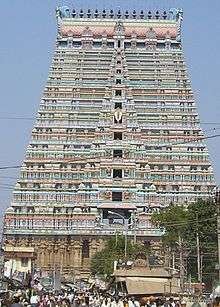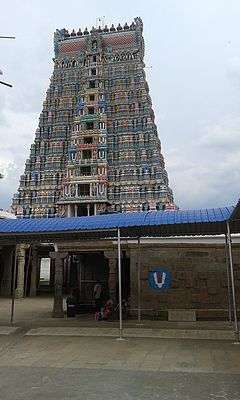Mangalasasanam by Divyadesam
The Alvars during the early medieval period of Tamil history (between the 7th and 10th centuries CE) worshipped Vishnu and his avatars through their hymns. This collection of their hymns is known as Divya Prabhandham. Mangalasasanam means "praying that the holy shrines be happy all the time". The Srivaishnava shrines that were sung about by the Alvars are called Divya Desams. The divyadesams that have the most number of pasurams sung upon them are Srirangam (247), Thirumala (202), Thirumaliruncholai and Thirukannapuram (128 each).
Azhwars
The word azhwar means the one who dives deep into the ocean of the countless attributes of god. Azhwars are considered the twelve supreme devotees of Vishnu, who were instrumental in popularising Vaishnavism during the 5th-8th centuries A.D. The religious works of these saints in Tamil, songs of love and devotion, are compiled as Nalayira Divya Prabandham containing 4000 verses and the 108 temples revered in their songs are classified as Divya desam.[1][2] The saints had different origins and belonged to different castes. As per tradition, the first three azhwars, Poigai, Bhutha and Pey were born miraculously. Tirumizhisai was the son of a sage, Thondaradi, Mathurakavi, Peria and Andal were from brahmin community, Kulasekhara from Kshatria community, Namm was from a cultivator family, Tirupana from panar community and Tirumangai from kazhwar community. Divya Suri Saritra by Garuda-Vahana Pandita (11th century AD), Guruparamparaprabavam by Pinbaragiya Perumal Jiyar, Periya tiru mudi adaivu by Anbillai Kandadiappan, Yatindra Pranava Prabavam by Pillai Lokacharya, commentaries on Divya Prabandam, Guru Parampara (lineage of Gurus) texts, temple records and inscriptions give a detailed account of the azhwars and their works. According to these texts, the saints were considered incarnations of some form of Vishnu. Poigai is considered an incarnation of Panchajanya (Krishna's conch), Bhoothath of Kaumodakee (Vishnu's Mace/Club), Pey of Nandaka (Vishnu's sword), Thirumalisai of Sudarshanam (Vishnu's discus), Namm of Vishvaksena (Vishnu's commander), Madhurakavi of Vainatheya (Vishnu's eagle, Garuda), Kulasekhara of Kaustubha (Vishnu's necklace), Periy of Garuda (Vishnu's eagle), Andal of Bhoodevi (Vishnu's wife, Lakshmi, in her form as Bhudevi), Thondaradippodi of Vanamaalai (Vishnu's garland), Thiruppaan of Srivatsa (An auspicious mark on Vishnu's chest) and Thirumangai of Saranga (Rama's bow). The songs of Prabandam are regularly sung in all the Vishnu temples of South India daily and also during festivals.[2][3]
According to traditional account by Manavala Mamunigal, the first three azhwars namely Poigai, Bhoothath and Pey belong to Dwapara Yuga (before 4200 BC). Modern historians place the period of azhwars from the 5th to 8th century AD, but there is dispute about the chronology and relation between each other. But it is widely accepted by tradition and historians that the trio are the earliest among the twelve azhwars.[1][2][4][5][6] Along with the three Saiva nayanmars, they influenced the ruling Pallava kings, creating a Bhakti movement that resulted in changing the religious geography from Buddhism and Jainism to these two sects of Hinduism in the region. The azhwars were also instrumental in promoting the Bhagavatha cult and the two epics of India, namely, Ramayana and Mahabaratha.[7] The azhwars were instrumental in spreading Vaishnavism throughout the region.[8] The verses of the various azhwars were compiled by Nathamuni (824-924 AD), a 10th-century Vaishnavite theologian, who called it the "Tamil Veda".[9][10]
The following table lists the azhwars.
| S.No | Alwar Saint | Period and Place | Other names | Pasurams(Songs) |
| 1 | Poigai Alvar | 7th century, Kanchipuram | Saro-yogi, Kaasaara-yogi,
Poigai-piraan, Padma-muni, Kavinyarporeyeru |
100 |
| 2 | Bhoothathalvar | 7th century, Thirukadalmallai (Mahabhalipuram) | 100 | |
| 3 | Peyalvar | 7th century, Mylapore | Kairava-muni, Maha-daahva-yaar, Thamizh-Thalaivan | 100 |
| 4 | Thirumalisai Alvar | 7th century, Thirumazhisai | Bhakthi-saarar, Bhaargavar, Magisaaraapuriswarar, Mazhisai-piraan | 216 |
| 5 | Nammalvar | 9th century, Azhwar Thirunagari (Kurugur) | Sadagopan, Sadaari, Paraankusun, Maaran, Vakulaa Baranan, Kurugaiyar-kone | 1296 |
| 6 | Madhurakavi Alvar | 9th century, Thirukollur | Inkaviyaar, Azhwaarukku Adiyaan | 11 |
| 7 | Kulashekhara Varman | 8th century, thirvanjikkolam | Kolli-kaavalan, Koodal-naayakan,
Koyikone, Villavar-kone, Cheyralar-kone |
105 |
| 8 | Periyalvar | 9th century, Sri Villiputhur | Vishnu-chitthar, Patta-naadan, Battar-piraan, Sri-Villiputthooraar, Sriranganaatha-Svasoorar | 473 |
| 9 | Andal | 9th century, Sri Villiputhur | Choodikoduttha Naacheyaar, Godai,
Godai-piraatti |
173 |
| 10 | Thondaradippodi Alvar | 8th century, Thirumandangudi | Vibranaaraayanar, Thirumandangudiyaar,
Bhakthangirirenu, Palliunartthiya-piraan |
58 |
| 11 | Thiruppaan Alvar | 8th century, Uraiyur | Paanar, Muni-vaahanar,
Yogi-vaahanar, Kaveeswarar |
10 |
| 12 | Thirumangai Alvar | 8th century, Thirukurayalur | Kaliyan, Aalinaadan, NaaluKaviPerumaal,
Arulmaari, Parakaalan, Mangaiyarkone |
1253 |
Madhurakavi Alvar sang only in praise of his guru - Nammalvar and has not done mangalasasanam on any Divya Desam. The following table lists the number of paasurams (hymns) sung by each Alvar on each Divya Desam. [11]
List of Divyadesam and Number of songs for each temple
The following table lists the number of verses for each divyadesam
| Number of Pasurams(hymns) | 1 | 2 | 4 | 5 | 6 | 7 | 9 | 10 | 11 | 12 | 13 | 14 | 20 | 21 | 22 | 24 | 27 | 32 | 33 | 36 | 39 | 40 | 42 | 45 | 47 | 50 | 51 | 110 | 128 | 202 | 247 |
| Number of Divyadesams | 15 | 8 | 2 | 2 | 2 | 1 | 1 | 23 | 14 | 8 | 5 | 3 | 1 | 2 | 3 | 1 | 1 | 1 | 1 | 1 | 1 | 1 | 1 | 1 | 1 | 1 | 2 | 1 | 2 | 1 | 1 |
Mangalasasanam Classification
The below table provides a classification for Mangalasananam [12]
| Prabandam | Azhwars (poet) | Number of Pasurams (songs) |
| Mudal Aayiram (First thousand) | 947 | |
| Tiruppallandu | Periyalvar | 10 |
| Periyaazhwar Thirumozhi | Periyalvar | 463 |
| Tiruppaavai | Andal | 30 |
| Naachiyaar Thirumozhi | Andal | 143 |
| Perumaal Thirumozhi | Kulashekhara | 105 |
| Thiruchanda Virutham | Thirumalisai Alvar | 120 |
| Tirumaalai | Thondaradippodi Alvar | 45 |
| Tiruppalli | Thondaradippodi Alvar | 10 |
| Amalaanathi Piraan | Thiruppaan Alvar | 10 |
| Kanninum Siru Thaambu | Madhurakavi Alvar | 11 |
| Periya Thirumozhi (Greater Hyms) | 1134 | |
| Periya Thirumozhi | Thirumangai Alvar | 1084 |
| Thiru Kurun Thaandagam | Thirumangai Alvar | 20 |
| Thiru Nedun Thaandagam | Thirumangai Alvar | 30 |
| Moondram Ayiram | 701 | |
| Mudal Thiruvandaadhi | Poigai Alvar | 100 |
| Irandaam Thiruvandaadhi | Boothath alvar | 100 |
| Moondraam Thiruvandaadhi | Peyalvar | 100 |
| Naanmugan Thiruvandaadhi | Thirumalisai Alvar | 96 |
| Thiru Virutham | Nammalvar | 100 |
| Thiru Vaasiriyam | Nammalvar | 7 |
| Periya Thiru Andaathi | Nammalvar | 87 |
| Thiruvezukootrirukkai | Thirumangai Alvar | 1 |
| Siriya Thirumadal | Thirumangai Alvar | 40 |
| Periya Thirumadal | Thirumangai Alvar | 78 |
| Ramanuja Nootranthathi | Tiruvarangathu Amuthanar | 108 |
| ThiruvaaiMozhi (Divine Hyms) | 1102 | |
| Thiruvaai Mozhi | Nammalvar | 1102 |
Famous Divyadesams
-

Srirangam Temple
-

Srivilliputhur Temple
Notes
- 1 2 Rao, P.V.L. Narasimha (2008). Kanchipuram – Land of Legends, Saints & Temples. New Delhi: Readworthy Publications (P) Ltd. p. 27. ISBN 978-93-5018-104-1.
- 1 2 3 Dalal 2011, pp. 20-21
- ↑ Ramaswamy, Vijaya (2007). Historical Dictionary of the Tamils. Scarecrow Press. p. 211. ISBN 9780810864450.
- ↑ Aiyangar, Sakkottai Krishnaswami (1920). Early history of Vaishnavism in south India. Oxford University Press. pp. 17–18.
- ↑ Lochtefeld, James (2002). The Illustrated Encyclopedia of Hinduism: N-Z. The Rosen Publishing Group. p. 515. ISBN 9780823931804.
- ↑ Krishna (2009). Book Of Vishnu. Penguin Books India. p. 136. ISBN 9780143067627.
- ↑ B.S. 2011, p. 42
- ↑ B.S. 2011, pp. 47-48
- ↑ Mukherjee (1999). A Dictionary of Indian Literatures: Beginnings-1850 Volume 1 of A Dictionary of Indian Literature, A Dictionary of Indian Literature. Orient Blackswan. p. 15. ISBN 9788125014539.
- ↑ Garg, Gaṅgā Rām (1992). Encyclopaedia of the Hindu World: Ak-Aq. Concept Publishing Company. pp. 352–354. ISBN 9788170223757.
- ↑ "About each divyadesam". www.divyadesamonline.com. Archived from the original on 2007-06-23. Retrieved 2007-07-06. External link in
|work=(help) - ↑ http://www.108-divya-desam.com/azhwars-and-naalaayira-divya-prabhandam/
References
- B. S., Chandrababu; S., Ganeshram; C., Bhavani (2011). History of People and Their Environs. Bharathi Puthakalayam. ISBN 9789380325910.
- Chari, S. M. Srinivasa (1997). Philosophy and Theistic Mysticism of the Āl̲vārs. Motilal Banarsidass Publishers. ISBN 9788120813427.
- Dalal, Roshen (2011). Hinduism: An Alphabetical Guide. Penguin Books India. ISBN 9780143414216.
- Das, Sisir Kumar; Sāhitya Akādemī (2005). A history of Indian literature, 500-1399: from courtly to the popular. chennai: Sāhitya Akādemī. ISBN 81-260-2171-3.
- Ramanujan, Attipat Krishnaswami (2005). Hymns for the Drowning: Poems for Vishnu. Penguin Books. ISBN 9780144000104.
- Govindāchārya, Aḷkoṇḍavilli (1902). The Holy Lives of the Azhvârs: Or, the Drâvida Saints. Mysore: G. T. A. Press.

